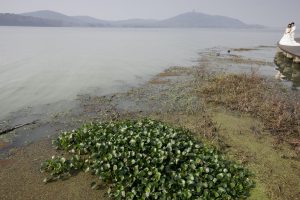China’s urbanites use a lot of water. Every day, more than 4,000 water-treatment plants supply 60 million tonnes of water to 400 million people living in Chinese cities. Despite the impressive figures, the water industry is grappling with widespread criticism as concerns grow about the quality of its product.
The extent of the problem of China’s “dirty taps” remains elusive, however. While almost all academics in the field argue the country's urban water supplies pose a “potential safety hazard”, practically no water-treatment plant rates its own water as below standard. When it comes to the water flowing into Chinese homes, the situation is looking rather cloudy.
In late 2009, the unit responsible for monitoring water quality in China’s cities (part of the Ministry of Housing and Urban-Rural Development) carried out a survey of urban supplies. The results were never formally released to the public, but early last month, more than two years after the study was carried out, China's Century Weekly published the leaked survey data. The figures were striking: of more than 4,000 water-treatment plants surveyed at county level and above, “at least 1,000” were supplying water that failed to meet standards, the report said.
This news was swiftly followed by release of more recent data from China’s health authorities. Wang Xuening, a health ministry official, said that figures gathered by a pilot monitoring scheme in 2011 suggested that 80% of the country’s urban tap water was up to standard.
That still leaves a 20% problem area. But after the news was reported, water bureaus from across the country came out to say the water from their treatment plants was up to scratch – the major cities Beijing, Shanghai and Guangzhou; the country’s provincial capitals, such as Nanjing, Hangzhou, and Changsha; and finally dozens of "tier three" cities including Ningbo, Suzhou and Jiaxing staunchly defended the quality of their processed water.
Liu Wenjun, former director of the Division of Drinking Water Safety at Tsinghua University in Beijing is unphased by this outpouring. It is par for the course that local plants will swear their water is up to standard, he said. “Unless local people actually put the problem in front of their eyes – physically showing them that their water is yellow or has a strange smell – then the treatment plants will never admit there is a problem with quality,” he said.
Water experts point out that the severity of urban water pollution has stayed pretty much static in the two years between the 2009 and 2011 surveys; around 50% of sources are polluted. If you want to turn water like that into a tap-worthy product, at the very least you need to pump it through water-treatment plants equipped with the most advanced technology. But Chinese plants have widely failed to upgrade their systems in recent years.
At the end of 2009, around 98% of the 4,000 water-treatment plants in cities above county level were still using conventional technology, according to a source close to the housing ministry’s urban water-quality monitoring centre. Today, only a handful of water-treatment plants – in major cities like Beijing, Shanghai, Guangzhou and Shenzhen – are using cutting-edge methods, a situation that seems unlikely to change soon: “By the time new drinking-water standards are scheduled to come into effect on July 1, 2012, the proportion of water-treatment plants using advanced technology will have only increased by a single percentage point [since the end of 2009],” the source said. This means that, in the two-year gap between the two surveys, the percentage of plants using advanced technology increased at the most from 2% to 3% of the country’s total.
While concerns about water quality rumble on, many also worry that the country’s new drinking-water standards – published at the end of 2006 and due to come into effect by July 1 this year – will prove a damp squib. These standards are meant to be in line with international norms and will use a total of 106 indicators. But critics argue these standards have “no teeth”: the authorities will have no matching set of penalties to dish out to those who breach them. As a result, local governments and water-treatment plants are unlikely to be cowed.
Meanwhile, in the five years since the plans for new standards were made public at the end of 2006, there has been little progress in upgrading water-treatment processes or transforming the country’s outdated network of water pipes. Chief engineer at the housing ministry’s water-quality monitoring unit Song Lanhe said that, in the immediate term, the new standards are only likely to act as a guide, and will be difficult to enforce. Local governments will continue to claim that their water quality “meets standards”.
As the date by which the new standards must be introduced draws closer, the academic community is increasingly despondent. Wang Zhansheng, a professor at Tsinghua University’s environmental studies department, pointed out that it won’t even be compulsory for treatment plants to test their water against all 106 indicators: results for more than 60 of the new measures will be “decided by consultation between the department in charge of local water and the health administration department.” This requirement is meant to improve the efficiency of inspections and save on monitoring costs.
There is another problem. While the supposedly strict new standards include 106 indicators, whether or not the water makes the grade depends on an overall average. As long as the water gets a top-line score of 95%, then it is considered up to standard. Only a handful of these 106 points are compulsory to test –the most important markers of water quality – but by using the non-compulsory measures too, localities can bump up their average. In other words, the water could fail on a number of key indicators and still pass overall.
Wang Zhansheng explained: “Under the old system, if a plant failed to meet standards on two indicators then it couldn’t reach 95%. Now, even if it fails on five indicators, the overall water quality can still make the grade.” In addition, water-treatment plants are only required to make inspections twice a year, giving them a lot of scope to fiddle the books.
There are three basic reasons why it is difficult to establish the truth about tap-water quality. The first is that the frequency of water-quality testing at treatment plants is too low due to insufficient capacity to run tests. Of China’s 35 major cities, only 40% have the capacity to test for all 106 indicators. And that’s the major cities – prefecture-level cities and county-level cities are also meant to submit samples for testing. A large number of county-level plants don’t even have the capacity to assess their water against conventional standards.
The second reason is that self-testing is widespread. In China, there are only a couple of water-quality monitoring bureaus that are independent of water-treatment plants. The bulk of the monitoring work – whether you’re talking about the unit at the housing ministry, national or local monitoring stations – is done by the internal laboratory at the water-treatment plant in question. You get two names on paper, but it’s the same group of people behind the results.
The third reason is that the water-treatment plants are not transparent about their water quality, and there is no mechanism to force them to be. And, while local health departments also have a system for testing water quality, they tend to keep the data to themselves. Both systems are controlled by the local government and the data is rarely shared with the public.
On top of that, water-quality testing in China largely focuses on the water flowing out of treatment plants – there is no way of knowing the quality of the water by the time it is piped into homes. Even if the water churned out of the treatment plant is up to standard, old-fashioned plumbing systems make it difficult to ensure clean water flows from a household tap.
Meanwhile, the prospects for national groundwater quality remain bleak. On May 10, the Ministry of Land and Resources released a statement that 45% of groundwater from 4,727 testing sites in 200 cities across China was graded as excellent, good or fair, while 55% was poor or very poor. The fundamental way to solve the tap water crisis is, of course, to clean up water resources. But realistically, it will take at least 15 to 20 years to effect this radical cure. The most urgent and practical choice for providing people with clean water is to upgrade the technology of the water-treatment plants.
Academics such as Wang Zhansheng have long argued that China’s urban water infrastructure is poor. In the past dozen or so years, there has been minimal spending in this area, leaving a serious investment deficit. The bottom line remains that China’s water resources are seriously polluted, and the vast majority of water-treatment plants need to adopt advanced technology. This is particularly urgent for the areas of the country where water pollution is most serious.
Liu Wenjun said that, while the whole world has grappled with plumbing problems in the past, in recent decades developed countries have basically solved the secondary pollution problem by updating infrastructure and using technology to maintain a stable, reliable and clean water supply. Technology is not an obstacle to solving the pipe network issue; lack of local investment is.
Song Lanhe said national managers need to get a grip on the problems associated with tap-water supply and water-quality testing. In the same way that a network was set up to monitor PM 2.5 – the pollutant at the centre of a major public campaign for better data on urban air quality in 2011 – money must also be invested in building up water-quality monitoring at a local level and improving the testing capabilities of treatment-plants everywhere.
Even more importantly, academics argue that China must start third-party testing, so that the public can access information from both independent auditors and water-treatment plants themselves. Only then will the cloudy waters begin to clear.
Gong Jing is a reporter at Century Weekly and Wang Haotong an intern at chinadialogue. This article draws on a series of articles on China's tap-water situation featured in Century Weekly, a Caixin publication.
Homepage image by exing



